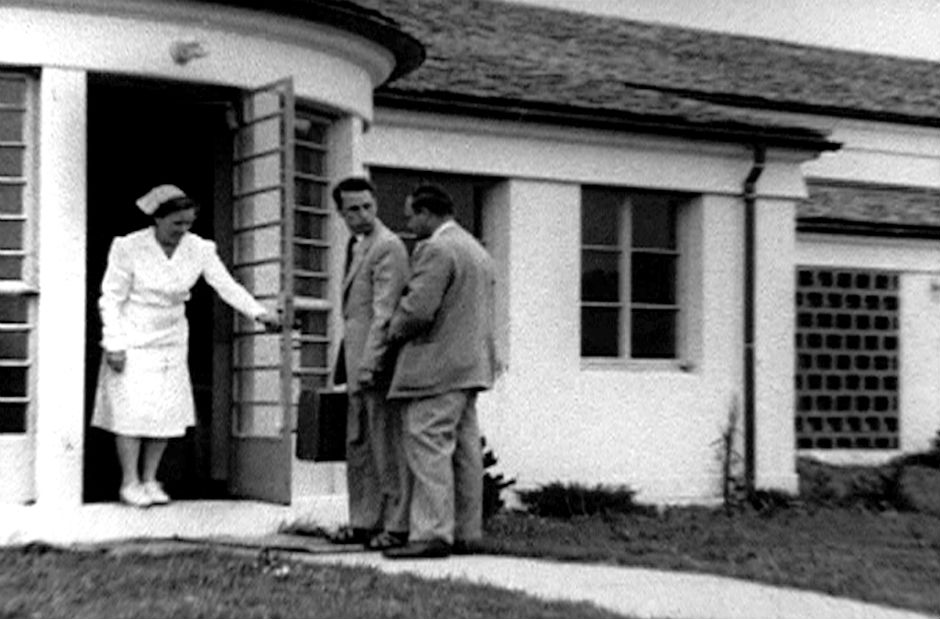False Friends
Falsche Freunde

Length: 4:50 mins
Year of production: 2007
Exhibition Format: Quicktime file
Source Format: 16mm found footage
Language: No language
Selected Music by: Violet
Synopsis: A montage of mid-century found footage: mysterious strands are obsessively braided to create a poetic reflection about an anxious interplay of memory and projection.
Statement: The title of my film False Friends refers to a linguistic term for translational difficulties. False Friends are pairs of words in two languages that look or sound similar, but differ in meaning. The word "gift," for example, exists in both English and in German. In English, the word refers to an offering; in German, the word means poison. (For more examples, follow this external link.) I was interested the inherent, narrative character of the term, but to me, also, the concept of a False Friend is be a perfect metaphor for memory: one occurrence in the past may be remembered by two people collectively, however, it can produce completely different meanings / understandings / significances of the same event. (San Francisco, December 20, 2008, Sylvia Schedelbauer)
“Imagination, of course, can open any door - turn the key and let terror walk right in.” Truman Capote, In Cold Blood
–––False Friends (2007) ups the ante, so to speak, adding noir-like suspense to Schedelbauer’s repertoire. In the spirit of the title—a phrase that refers to words which, though identically spelled in two languages, mean different things—she repeats a select number of images, crosscutting them with others to imply both complementary and contradictory meanings. The opening shot of newborns in a hospital nursery seems linked somehow to the two men greeted by a nurse at the entrance of a medical building. But the latter is interrupted repeatedly by images of unspecified menace: a possible intruder exploring a house with a flashlight, a figure running through a darkened terrain from some undetermined danger. Shots of a nude couple making love, seen briefly and translucently, may be Schedelbauer’s imagining of a primal scene—both intimate and remote—imbued with cultural ambiguity. In the penultimate shot, the figure seen running throughout suddenly pauses and looks off-screen left, in the direction, the editing implies, of the men who have just been admitted to the building by the nurse. In welding two segregated pieces of found footage into quasi-narrative coherence, this gaze, symbolically, might be that of Schedelbauer herself, in poignant pursuit of the very connective tissue that eludes her. (Tony Pipolo, Artforum)
–––With the simple means of old black-and-white archive material and rather familiar, albeit slightly alienated horror soundtrack, the director manages to draw the viewer into the nightmarish atmosphere of the images by the unsettling rhythm of the cuts. Falsche Freunde takes place in the undefined space between video art and feature film narration. The oppressive tension never abates, even though the mysteriousness, which is reminiscent of David Lynch, of the dark - in both senses of the word - scenes do not look set to be deciphered. (Jury statement, German Film Critics' Award: Best Experimental Film 2008)
Already in False Friends, we see Schedelbauer exercising the dominant aesthetic in her oeuvre. Archival material is again utilized, combined with syncopated flash frames that structure the rhythm of the piece. Mysterious, shadowy figures populate this work. One gets the sense of a narrative taking shape but then repeatedly being aborted – men in suits attempting to enter a home, anonymous sex, sterile hospitals. From family we move to friends, or a lack thereof. The slow and tense musical noise expresses the incomprehensibility of relationships on anything other than superficial terms. Still, one can feel the artist reaching out to touch something, to turn the fake into the real, to actualize. (Greg de Cuir, Jr., program notes, Academic Film Center, Belgrade)
–––The archival material edited in this video, recalls the functioning of memory, when we are lost in our thoughts it is as if we were making a journey without borders between what we lived and what we would like to live, as if space and time were canceled and liquefied one inside the other without interruption. The images flow, they go back, they go on slowly then dissolve into other images, a neonatal unit, running children, people having sex, men entering a hospital, the sound that surrounds us as if this journey really belonged to us, as if those images were ours. (Stefano Romano, program notes, Art House Shkodër)
Awards
2008 German Film Critics' Award: Best Experimental Film
2008 Oslo Screen Festival, honorable mention